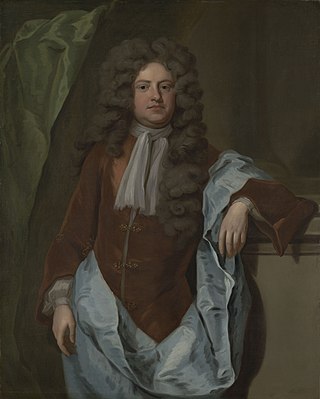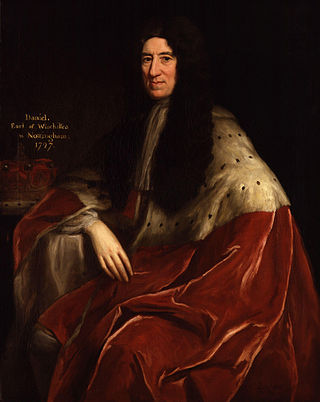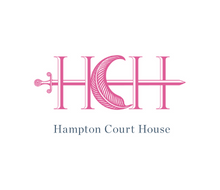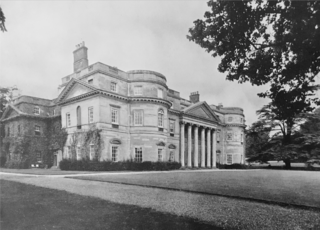Related Research Articles

Charles Montagu, 1st Earl of Halifax, was an English statesman and poet. He was the grandson of the 1st Earl of Manchester and was eventually ennobled himself, first as Baron Halifax in 1700 and later as Earl of Halifax in 1714. As one of the four members of the so-called Whig Junto, Montagu played a major role in English politics under the reigns of King William III and Queen Anne. He served as Chancellor of the Exchequer from 1694 to 1699 and as First Lord of the Treasury from 1714 until his death the following year. He was also president of the Royal Society and a patron of the scientist Isaac Newton.

Daniel Finch, 2nd Earl of Nottingham, 7th Earl of Winchilsea PC was an English Tory politician and peer who supported the Hanoverian Succession in 1714. Known as Lord Nottingham until 1729, then as Lord Winchilsea.

George Montagu-Dunk, 2nd Earl of Halifax, was a British statesman of the Georgian era. Due to his success in extending commerce in the Americas, he became known as the "father of the colonies". President of the Board of Trade from 1748 to 1761, he aided the foundation of Nova Scotia, 1749, the capital Halifax being named after him. When Canada was ceded to the King of Great Britain by the King of France, following the Treaty of Paris of 1763, he restricted its boundaries and renamed it "Province of Quebec".

Earl of Halifax is a title that has been created four times in British history—once in the Peerage of England, twice in the Peerage of Great Britain, and once in the Peerage of the United Kingdom. The name of the peerage refers to Halifax, West Yorkshire.
Dunk or Dunks may refer to:

Hawkhurst is a village and civil parish in the borough of Tunbridge Wells in Kent, England. The village is located close to the border with East Sussex, around 12 miles (19 km) south-east of Royal Tunbridge Wells and within the High Weald Area of Outstanding Natural Beauty.
George Montagu, 1st Earl of Halifax, of Horton, Northamptonshire, was a British politician who sat in the House of Commons from 1705 to 1715 when he became a peer.

John Montagu, 5th Earl of Sandwich, PC, styled Viscount Hinchingbrooke until 1792, was a British peer and Tory politician.

Hampton Court House is a Grade II listed 18th-century building on the edge of Bushy Park in the London Borough of Richmond upon Thames. George Montagu-Dunk, 2nd Earl of Halifax, built the house in 1757. The estate is Grade II* listed on the Register of Historic Parks and Gardens.
The Hawkhurst Gang was a notorious criminal organisation involved in smuggling throughout southeast England from 1735 until 1749. One of the more infamous gangs of the early 18th century, they extended their influence from Hawkhurst, their base in Kent, along the South coast, where they successfully raided the Custom House, Poole. After they were defeated in a battle with the Goudhurst militia in 1747, two of their leaders, Arthur Gray and Thomas Kingsmill, were executed in 1748 and 1749, respectively.
Saint Ronan's School is an independent co-educational preparatory school for boys and girls from 3 to 13 years located in Hawkhurst in Kent, England. It currently has about 440 pupils, the majority of them day pupils, although boarding is available from Monday night through to Thursday night for all pupils from Year 4 upwards. The present headmaster is Joe Lewis. The school was named Tatler UK Prep School of the Year in 2017-2018 and TES Prep School of the Year 2021.
Events from the year 1661 in England.
George Sondes, 1st Earl of Feversham KB was an English politician who sat in the House of Commons at various times between 1626 and 1676 and was then created a peer and member of the House of Lords.
James Johnston was a general of the British Army, colonel of the Royal Horse Guards then colonel of the Scots Greys where he succeeded his sister's husband, George Preston.
Lady Barbara Montague was a British philanthropist and charity worker, who sponsored programs to assist primarily poor women. As an unmarried woman, and due to illness unable to live with family, she created an alternate family situation that allowed her independence. Joining a community of women in Bath, the group pooled their resources to provide support for each other and others in their community. Upon her death, she left bequests to continue providing for those who had been important in caring for her in her lifetime.

Anne Finch, Countess of Winchilsea and Nottingham, formerly Anne Hatton, was daughter of 1st Viscount Hatton and the second wife of Daniel Finch, 2nd Earl of Nottingham, and the mother of Daniel Finch, 8th Earl of Winchilsea. Lady Nottingham was appointed the Lady of the Bedchamber to Mary II of England in 1691, and served in that position until the Queen's death in 1694.
Charles Montagu, of Papplewick, Nottinghamshire. was a British landowner and politician who sat in the House of Commons between 1722 and 1759.

Thomas Kingsmill was an English outlaw and one of the leaders of the notorious Hawkhurst Gang of smugglers that operated, from its base in Kent, along the South Coast of England from 1735 until 1749. One of the more infamous gangs of the early 18th century, they extended their influence from Hawkhurst, their base in Kent, along vast swathes of the South coast.

Horton Hall, known locally as Horton House, was a stone-built Georgian stately home, now demolished, located on a 3,764 acre estate stretching across nine parishes on the Northamptonshire and Buckinghamshire borders.
References
- 1 2 Speck, W. A. "Dunk, George Montagu". Oxford Dictionary of National Biography (online ed.). Oxford University Press. doi:10.1093/ref:odnb/8266.(Subscription or UK public library membership required.)
- 1 2 3 Saint Ronan's School: Tongswood Estate. Tongswood – January 2010 version. Accessed 12 February 2022.
- ↑ Edward Hasted (1798). "Parishes: Hawkhurst". The History and Topographical Survey of the County of Kent: Volume 7. Institute of Historical Research. Retrieved 1 March 2013.
- ↑ Plaque #1472 on Open Plaques